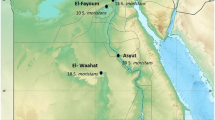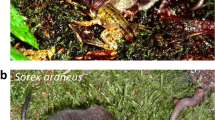Summary
Globiferous pedicellariae of Sphaerechinus granularis are venomous defensive appendages consisting of a stalk bearing a head made of three movable jaws. Each jaw is supported by a calcareous valve ending with a terminal grooved tooth. A venom apparatus is located in each jaw and consists of a venom gland surrounded by a muscular envelope and terminating in a duct which completely encircles the terminal tooth of the valve. Contrary to previous statements, the duct does not lie inside the groove of the terminal tooth. In mature pedicellariae, the venom is stored in intracellular vacuoles of highly differentiated cells which are no longer active. The cells fill the whole space of the venom gland which is without a lumen; they are segregated into two types that occur in distinct regions and differ from each other by morphological and staining properties of their secretions. Upon contraction of the muscular envelope, the venom is released via a holocrine mechanism and infiltrates the predator's tissues through the wound inflicted by the three calcareous teeth of the valves. In no case is the venom emitted through the tooth groove.
Similar content being viewed by others
References
Bücherl W (1971) Spiders. In: Bücherl W, Buckley EE (eds) Venomous animals and their venoms. III. Venomous invertebrates. Academic Press, London, pp 197–277
Campbell AC (1972) The form and function of the skeleton in pedicellariae from Echinus esculentus L. Tissue Cell 4:647–661
Campbell AC (1983) Form and function of pedicellariae: A review. In: Jangoux M, Lawrence JM (eds) Echinoderm studies, vol 1. Balkema, Rotterdam, pp 139–147
Cannone AJ (1970) The anatomy and venom emitting mechanism of the globiferous pedicellariae of the urchin Parechinus angulosus (Leske) with notes on their behaviour. Zoologica Africana 5:179–190
Chia FS (1970) Histology of the globiferous pedicellariae of Psammechinus miliaris (Echinodermata, Echinoidea). J Zool Lond 160:9–16
Foettinger A (1881) Sur la structure et la forme des pédicellaires gemmiformes de Sphaerechinus granularis et d'autres échinodermes. Arch Biol Paris 2:450–492
Fujiwara T (1935) On the poisonous pedicellariae of Toxopneustes pileolus. Annot Zool Japon: 15:62–69
Ganter P, Jolles G (1969–1970) Histologie normale et pathologique, 2 vols. Gauthier-Villars, Paris, pp 1–1904
Ghyoot M, De Ridder C, Jangoux M (1987) Fine structure and presumed function of the pedicellariae of Echinocardium cordatum (Echinodermata, Echinoidea). Zoomorphology 106:279–288
Hammann O (1887) Beiträge zur Histologie der Echinodermen. Helft 3. Anatomie und Histologie der Echiniden und Spatangiden. Gustav Fischer, Jena, pp 1–176
Harris P, Shaw G (1984) Intermediate filaments, microtubules and microfilaments in epidermis of sea urchin tube foot. Cell Tissue Res 236:27–33
Hilgers H, Splechtna H (1982) Zur Steuerung der Ablösung Giftpedizellarien bei Sphaerechinus granularis (Lam.) und Paracentrotus lividus (Lam.) (Echinodermata, Echinoidea). Zool Jahrb Anat 107:442–457
Holland ND, Grimmer JC (1981) Fine structure of the cirri and a possible mechanism for their motility in stalkless crinoids (Echinodermata). Cell Tissue Res 214:207–217
Holland LZ, Holland ND (1975) The fine structure of epidermal glands of regenerating and mature globiferous pedicellariae of a sea urchin (Lytechinus pictus). Tissue Cell 7:723–737
Jensen M (1966) The response of two sea-urchins to the sea-star Marthasterias glacialis (L.) and other stimuli. Ophelia 3:209–219
Kimura A, Hayashi H, Kuramoto M (1975) Studies of urchi-toxins: separation, purification and pharmacological actions of toxinic substances. Japan J Pharmacol 25:109–120
Moitoza DJ, Phillips DW (1979) Prey defense, predator preference, and non random diet: the interactions between Pycnopodia helianthoides and two species of sea urchins. Mar Biol 53:299–304
O'Connell MC, Alender CB, Wood EM (1974) A fine structure study of the venom gland cells in globiferous pedicellariae from Strongylocentrotus purpuratus (Stimpson). J Morphol 142:411–432
Péres JM (1950) Recherches sur les pédicellaires glandulaires de Sphaerechinus granularis (Lamarck). Arch Zool exp gén 86:118–136
Peters BH, Campbell AC (1987) Morphology of the nervous and muscular systems in the heads of pedicellariae from the sea urchin Echinus esculentus (L.). J Morphol 193:35–51
Rosenthal RJ, Chess JR (1972) A predator-prey relationships between the leather star Dermasterias imbricata and the purple sea urchin Strongylocentrotus purpuratus. Fish Bull 70:205–216
Schaefer N (1976) The mechanism of venom transfer from the venom duct to the fang in snakes. Herpetologia 32:71–76
Welsch JM (1966) Neurohumors and neurosecretions. In: Boolotian RA (ed) Physiology of Echinodermata. Wiley, New York, pp 545–560
Author information
Authors and Affiliations
Rights and permissions
About this article
Cite this article
Ghyoot, M., Dubois, P. & Jangoux, M. The venom apparatus of the globiferous pedicellariae of the toxopneustid Sphaerechinus granularis (Echinodermata, Echinoida): Fine structure and mechanism of venom discharge. Zoomorphology 114, 73–82 (1994). https://doi.org/10.1007/BF00396641
Accepted:
Issue Date:
DOI: https://doi.org/10.1007/BF00396641




